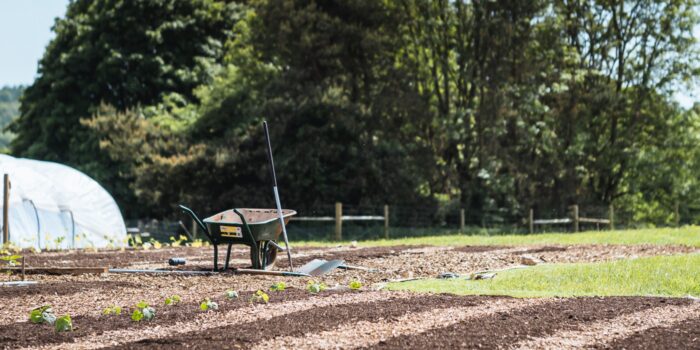Learn about the Estate at Combe Grove
The Estate at Combe Grove

With many projects planned in support of biodiversity, healthful nutrition and sustainable land management, the Estate Team work thoughtfully using permaculture practices and regenerative agriculture approaches to enhance the 64 acre estate and provide the most nutritious produce for the benefit of members and the wider Combe Grove community.
We recognise our environmental responsibilities above the current legal and regulatory requirements and the importance of our work as land stewards in maintaining and promoting biodiversity in this special part of the Bath countryside, ensuring its ecological health for future generations.
Establishing a heritage apple orchard at Combe Grove
One of the most recent projects was the planting of the heritage apple orchard, which you may have noticed when entering The Estate from the north entrance. In the meadow adjacent to Quarry Woods the orchard will become home to a wealth of wildlife. Some of the rare species that will call them home are the noble chafer beetle and the lesser spotted woodpecker. Fruit trees are also a good source of food for birds and badgers and they attract a number of pollinators, including moths, which are beneficial to bats as a food source. The site of the orchard was chosen for its location next to Quarry Woods, a Site of Special Scientific Interest (SSSI) and home to roosts of Greater and Lesser Horseshoe Bats.
Did you know that bats can live for a long time, living between 10 and 30 years?
Our land manager selected some of the oldest and rarest apple varieties in the UK. Here is a list:

- ‘Harvey’
- ‘Nonpareil’
- ‘Golden Pippin’
- ‘Decio’ – brought to the British Isles by a roman general
- ‘Blenheim Orange’
- ‘Leathercoat Russet’ – mentioned in Shakespeare’s Henry IV
- ‘Green Pippin’
- ‘Wyken Pippin’*
- ‘Powell’s Russet’
- Lemon pippin – thought to be from Norman England
- ‘Summer Golden Pippin’
- ‘Summer Pairmain’
- ‘Sops in Wine’
- ‘Spotted Pippin’
- ‘Old Pairmain’ – Oldest know variety known in the UK – 12AD
- ‘Winter Queening’
- ‘Scarlet Croften’
We have worked with Bernwode Fruit Trees, whose aim is to maintain heritage fruit tree species for future generations and encourage old varieties back into cultivation. You can read more about Bernwode and their ambition here.
Did you know that In the West Country, people used to pickle apples to keep them over the winter?
Preparing the land for mushrooms
The Estate Team have also been active inoculating coppiced hazel with mycelium in order to grow mushrooms. The species being planted include Pearl Oyster, Tarragon Oyster and Lions’ Mane. The latter, Hericium erinaceus belongs to the tooth fungus group. Easily identified by its long spines, the fruit bodies can be harvested for culinary use and alongside oyster mushrooms are considered a specialty mushroom. Research shows that Lions’ Mane may improve nerve function, protect nerves from being damaged and may also help prevent conditions such as anxiety, memory loss and Alzheimer Disease.

A note on mycelium
Not only used as a substrate for growing mushrooms, mycelium is a useful source of nutrients for other produce. Firstly, what is mycelium?
We often imagine mushrooms as the above soil part of the fungus, but the most vegetative parts are actually found underground. The aerial part of the fungus is called the fruiting body, while the root system of the fungus is called the mycelium. Mycelium is an essential part of the survival system of fungi which are like long roots that extend in soil, plants, wood and other materials to absorb water and nutrients.
One of the reasons we practice the ‘no dig’ method of growing vegetables on The Estate is to allow the mycelium in the soil to entangle themselves on roots of other plants to help provide the nourishment they need, meaning that we don’t have to. Permaculture practices mean that we respect the natural growing system which sustains a continuous cycle maximising the natural nourishment of our produce.
Reusing coffee grounds for the benefit of your soil
At Combe Grove we aim to reuse and reduce waste as much as we can as part of our sustainability ambitions. From the chipping of recently felled Ash trees for use on the land, the installation of dead hedging around the tennis courts and the composting of all green waste, attention has turned to finding ways to reuse waste from other parts of our operation. Coffee grounds, a by-product from The Caff, contain several key nutrients required for healthy plant growth. Added to this, they attract worms to the soil and can decrease the concentration of heavy metals. Great to dig into a compost heap or your flower beds, coffee grounds are a highly beneficial fertiliser that provide organic matter to your garden, improving drainage and water retention.

Pick up a bag or two of nutrient filled coffee grounds the next time you visit The Caff
Read more on the recent development work on The Estate at Combe Grove or visit our other journal posts